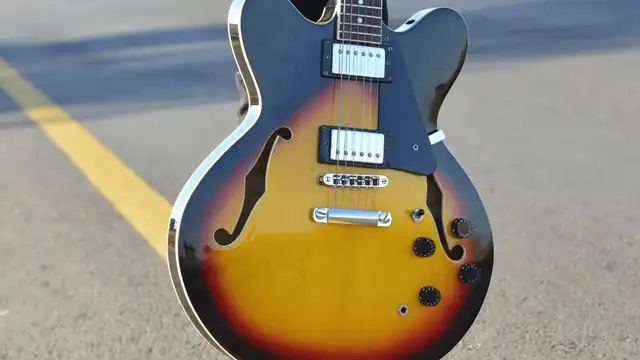How I created my own custom guitar string set


 My new custom tele, all decked out with its fresh strings.
Now, I've been experimenting with custom strings for quite some time, so when I built out my newest telecaster, I knew there were a few things I was after:
My new custom tele, all decked out with its fresh strings.
Now, I've been experimenting with custom strings for quite some time, so when I built out my newest telecaster, I knew there were a few things I was after:
1. I wanted to start with a .010 gauge.
I've been playing .011s on my hollow body, and while I like the added tension on that guitar — especially with the shorter 24.75" Gibson scale — I knew I wanted to be able to bend a bit easier on this tele. Plus, I've always felt like .010s are the right tone for a tele, 9s sound way too flimsy, but 11s don't really bring out the twang the same way 10s do.2. I wanted a wound 3rd
As some of you might know, I'm a bit of a wound 3rd addict. After all, the guitar was originally intended to have a wound 3rd, it just intonates and holds tune better. One of the biggest reasons I got into customizing my strings was that I thought it was dumb to only be able to get a wound 3rd set in 11s or 12s, when they make lighter wound strings. Anyway, a wound 3rd has always been my favorite way to tame the twang down just a bit on teles — I like it on the top two strings, but it just gets so aggressive on the 3rd string. Above all, I wanted a wound 3rd that was light enough for me to be able to bend it like a plain string, but for it to have all the sonic advantages of a wound string.3. I wanted a fat(ish) bottom end
I've always liked the added power of heavier bottom end strings, but I've long felt that the traditonal Light Top/Heavy Bottom sets can be a bit too much of you aren't downtuning. I've always like a bottom end that's midway between a Light set (26-36-46) and a Light Top/Heavy Bottom set (30-42-52). For years I had the hardest damn time finding 28s, 38s, 48s or 50s anywhere, as they're fairly uncommon gauges to most players, fortunately, I don't have that problem anymore!4. I wanted a 6th string that could hold its muster
I don't drop-tune too often on my tele, so I wasn't concerned about getting anything super heavy on the bottom, but I do definitely play in Drop D every so often. There's nothing I hate more than having a loose, floppy 6th string when you tune down (on most sets you can actually hear the string hitting the frets because it's so floppy. So, I wanted to come up with a set that would give me enough tension on the 6th string for the occasional Drop D song, without sounding out of balance when I'm playing in standard, which is most of the time.So, what did I end up going with?
After a bit of trial and error, here's what I settled on:.010 - .013 - .018w - .028 - .038 - .050
I went back and forth a few times on the bottom end, first starting with .030 - .040 - .052, then backing off a bit to where I ended up. As you can see in the tension read-out, this gives me a really nicely balanced tone, with just about 5lbs more tension on the bottom 3 strings than I have on the top. For those wondering, this is totally normal and 100% safe for your guitar, though you defintely don't want to get up to a 10lb differential, for a number of reasons.| String # | Scale Length (in.) | Pitch | String | Tension (lbs) |
| 1 | 25.5 | E4 | Plain .010 | 16.2 |
| 2 | 25.5 | B3 | Plain .013 | 15.4 |
| 3 | 25.5 | G3 | Nickel .018 | 16.1 |
| 4 | 25.5 | D3 | Nickel .028 | 21.3 |
| 5 | 25.5 | A2 | Nickel .038 | 21.6 |
| 6 | 25.5 | E2 | Nickel .050 | 21.2 |
How do they sound?
Well, in a word, great! I couldn't be happier with this setup. The bottom end is just right for me and balances really nicely with the rest of the set, while also giving me enough power for some intense, and occasionally sloppy, blues playing. Above all, I'm in love with the .018 wound 3rd string. It really feels just like a plain string, but sounds like a wound string—I'm in heaven!Lessons learned:
More than anything, the moral of the story is that trial and error is the name of the game. You won't always get it right on the first effort, and that's OK. It's worth it in the end to find the perfect setup. If you're working on building out a set of your own, don't hesitate to try something different. The worst thing that could happen is you'll have an experience with something new, which is always good for your playing. As always, if there's anything we can help with to make the process easier, let us know. We're always happy to help you find the perfect set.Other Posts you may like

Guitar Strings Order: How the Guitar is Tuned and Why

Best Acoustic Guitar Strings for Beginners

Two Handed Tapping: Our Top 8 Tappers of All Time

Which Guitar Strings Wear Your Fret Wire Down More?

What is Nashville Tuning? Its History, Best Guitar Strings & Uses

Guitar Scale Length Explained: String Tension & Playability
0 Responses
Leave a Reply
Your email address will not be published. Required fields are marked *




